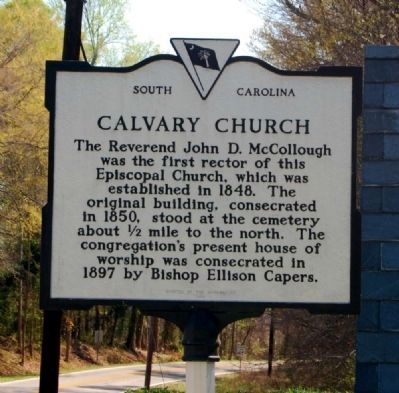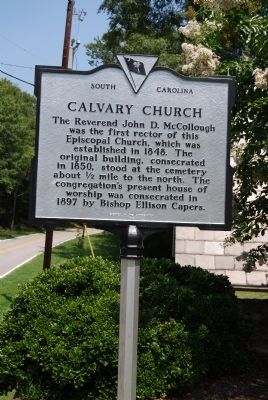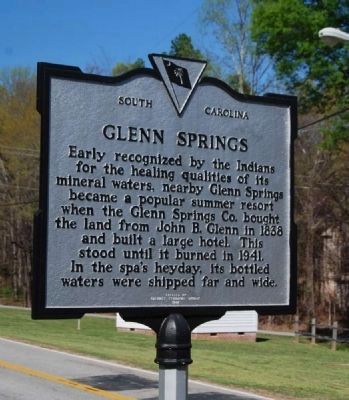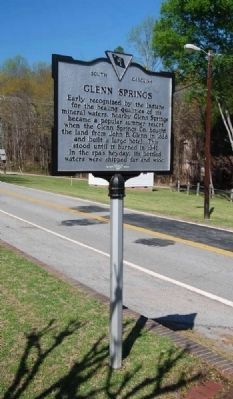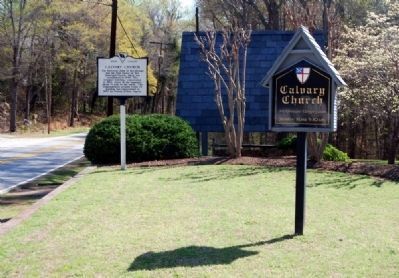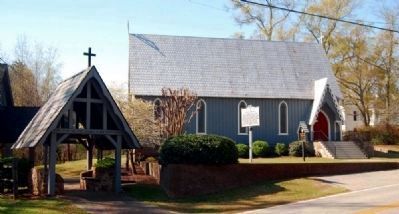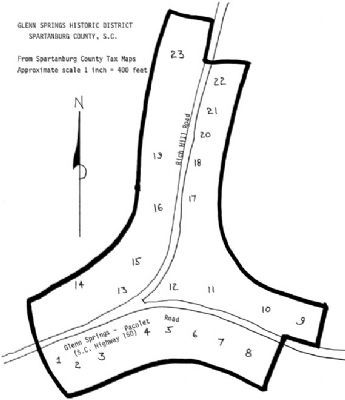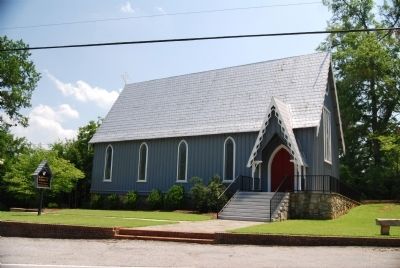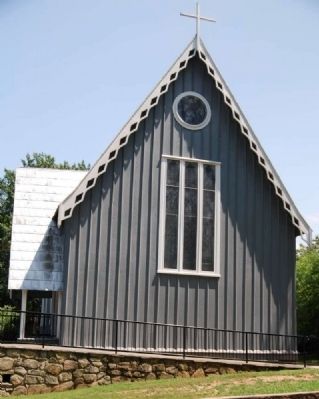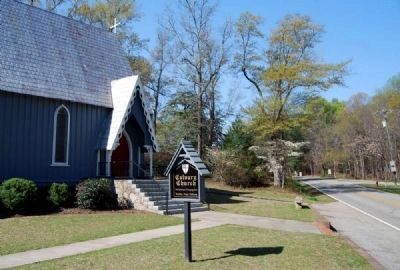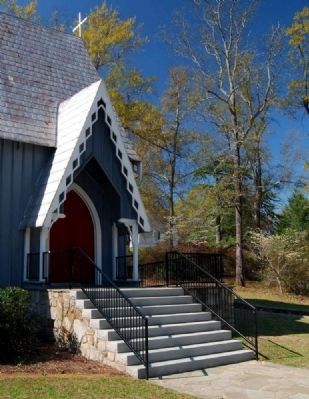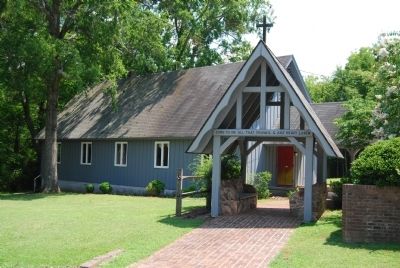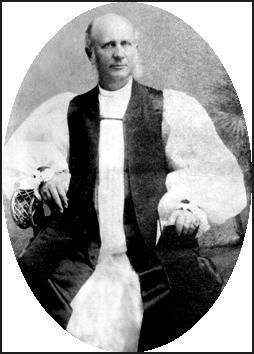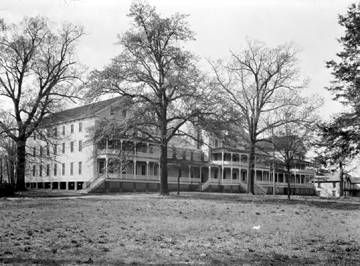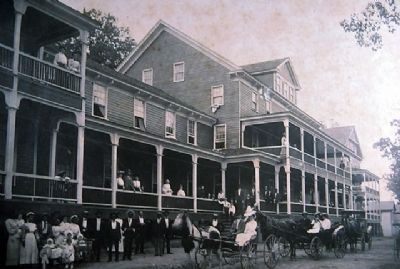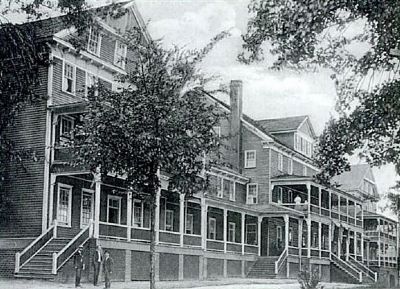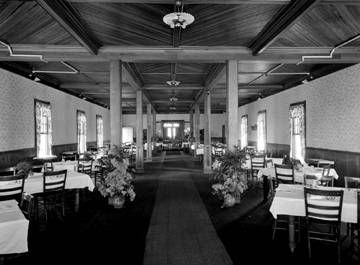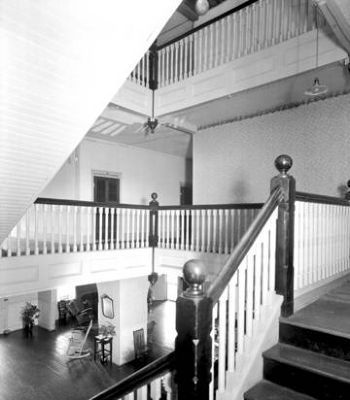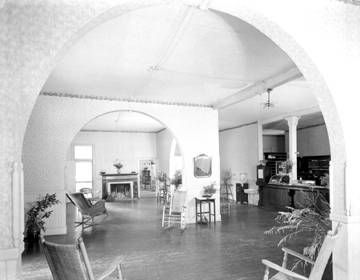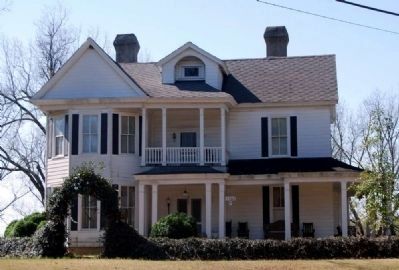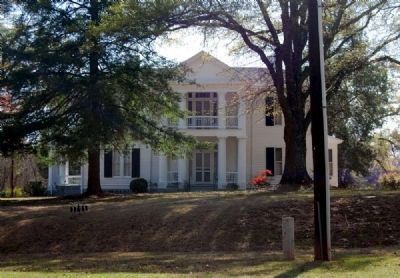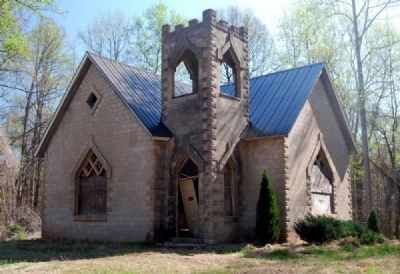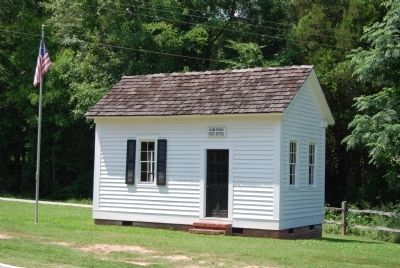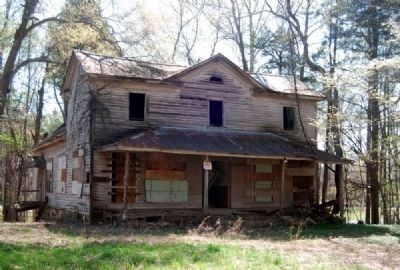Pauline in Spartanburg County, South Carolina — The American South (South Atlantic)
Calvary Church / Glenn Springs
Erected 1982 by Calvary Church Congregation. (Marker Number 42-11.)
Topics. This historical marker is listed in these topic lists: Churches & Religion • Native Americans • Settlements & Settlers. A significant historical year for this entry is 1848.
Location. 34° 48.965′ N, 81° 49.84′ W. Marker is in Pauline, South Carolina, in Spartanburg County. Marker is on Glenn Springs Road (State Highway 150) near Boys Home Road. Touch for map. Marker is at or near this postal address: 3685 Glenn Springs Rd, Pauline SC 29374, United States of America. Touch for directions.
Other nearby markers. At least 10 other markers are within 9 miles of this marker , measured as the crow flies. Welcome to Croft State Natural Area (approx. 3.2 miles away); Battle of Cedar Spring (approx. 7 miles away); Camp Croft (approx. 7.2 miles away); Emmanuel Baptist Church Veterans Monument (approx. 7.4 miles away); “Kate Barry” (approx. 8 miles away); Walnut Grove Plantation (approx. 8 miles away); Marysville School (approx. 8.1 miles away); Pacolet River Heritage Preserve (approx. 8.3 miles away); Crash Site of USA AF A20G Havoc (approx. 8.4 miles away); S.J. Workman Highway (approx. 8.6 miles away).
Also see . . .
1. Ellison Capers. Ellison Capers (October 14, 1837 – April 22, 1908) was a school teacher, Confederate general in the American Civil War, theologian, and college administrator from South Carolina. (Submitted on March 1, 2009, by Brian Scott of Anderson, South Carolina.)
2. Glenn Springs, South Carolina. Glenn Springs is a ghost town in Spartanburg County, South Carolina, United States, located at a spring. (Submitted on August 3, 2008, by Brian Scott of Anderson, South Carolina.)
3. Glenn Springs, South Carolina. Touted for healing waters, Glenn Springs and its resort was many a traveler's favorite destination for nearly 60 years. (Submitted on April 21, 2011, by Brian Scott of Anderson, South Carolina.)
4. Glenn Springs Historic District. Glenn Springs Historic District is located in the community of Glenn Springs, which is situated in the foothills of the Blue Ridge Mountains. (Submitted on September 17, 2008, by Brian Scott of Anderson, South Carolina.)
5. Glenn Springs Preservation Society. The Mission of the Glenn Springs Preservation Society is to "identify, refurbish, protect, and preserve for posterity the historical sites of Glenn Springs for use by the community." (Submitted on June 10, 2009, by Jenny Echols of Glenn Springs, South Carolina.)
6. Palmetto Trail: Glenn Springs Passage. PDF of Glenn Springs Passage trail. (Submitted on March 1, 2009, by Brian Scott of Anderson, South Carolina.)
Additional commentary.
1. Glenn Springs Historic District
Description
Glenn Springs Historic District in southeast Spartanburg County is the historic nucleus of the small rural community that developed around a popular nineteenth and early twentieth century resort hotel. The district is situated at the junction of the Glenn Springs-Pacolet Road and the Rich Hill Road and includes nineteen historic properties within an area of approximately ninety acres. The buildings are situated in a heavily wooded area of rolling hills and little development. The nominated property includes the site of the mineral springs, the site of the Glenn Springs Hotel, and a pavilion associated with the resort. Other properties within the district are several residences, two boarding houses, the ruins of a residence, a store, a post office, two churches, and a cemetery, as well as several outbuildings. The buildings in the Glenn Spring Historic District date from the early nineteenth century to the early twentieth century. Very few modern buildings have been constructed in this part of Glenn Springs, and the late nineteenth-early twentieth century integrity of the community is intact.
Additional Information
Key buildings defining the historic character of the district.
2. Charlie Zimmerman House (S.C. Highway 150). A large two-story, frame house built by the son of John Zimmerman ca. 1890. The house has elements of Queen Anne design, including a projecting polygonal bay on the lest side of the facade, a one- and two-tier porch of asymmetrical design, and an irregular, picturesque massing. The integrity of the house has been compromised somewhat by the application of aluminum siding.
3. John C. Zimmerman House (S.C. Highway 150). This large two-story, frame house was built ca. 1854. The building has a U-shaped plan with large two-tier porticos on both the northeast and northwest elevations. These porticos are centered on identical three-bay elevations and have four stuccoed Doric columns on each tier. The entrances on each tier of each elevation have transoms and sidelights. Windows have paired four-over-four sash and louvered shutters. The metal downspouts feature the date 1854 and a star motif. The entrance hall on the west has a double staircase. Th the northwest of the house is a brick wellhouse with stuccoed brick arches.
4. Calvary Protestant Episcopal Church (S.C. Highway 150). A small frame, Carpenter Gothic church building constructed in 1897 to replace an earlier building. The design of the church is attributed to the Reverend John D. McCullough, who was the first minister at Glenn Springs and who designed numerous other church buildings around the state. The church is sheathed in vertical board-and-batten siding and features pierced vergeboards in the gable ends of the steeply pitched roof. A small entrance porch on the northeast side of the building has a similar vergeboard. The nave is five bays long with single lancet windows in each bay. A tripartite window and a rose window are in the northwest elevation. The roofing is patterned metal shingles. Celtic crosses are located on the east and west ends of the roof ridge. The interior of the church has exposed roof trusses and a carved altar.
14. Site of Glenn Springs Hotel. The Glenn Springs Hotel was
a vast, two-story, frame building, said to have been constructed ca. 1840 and expanded many times. The hotel was completely destroyed by fire in 1941. The site is heavily overgrown with no visible remnants of the building.
15. Presbyterian Church (Rich Hill Road). A small T-shaped church built of molded concrete blocks ca. 1910. A square bell tower with an entrance as its base rises at the junction of the nave and its transept. The entrance, the windows of the church, and the apertures of the bell tower all have peaked concrete lintels with keystones suggesting Gothic pointed arches. Quoins along the corners of the bell tower are of contrasting rusticated concrete block. The building has standing-seam metal roofing. The church has been abandoned for many years and is in poor condition.
Other properties contributing to the historic character of the district:
6. Wooded property, underdeveloped.
8. Caspar Simpson House (S.C. Highway 150). A small one-story, frame bungalow, built ca. 1915, with a hip roof sheltering the house and a porch on the facade. Shingled piers carry the roof over the porch. The facade is three bays with a central entrance having transom and sidelights. Two brick chimneys and a shed-roofed dormer pierce the roof.
9. Cedar Grove (S.C. Highway 150). A large two-story, frame house, believed to have been built ca. 1800 and moved to its present location ca. 1837. The house has a five-bay facade with flushboard sheathing on the first story facade and weatherboard elsewhere. The central entrance has six-over-six sidelights and an elliptical fanlight. Window sash is nine-over-nine. The house has a single-pile, central-hall plan with a one-story, shed-roofed rear ell. Restoration of the house is in progress.
10. Paul C. Simpson House (S.C. Highway 150). A two-story, weatherboarded, frame house built ca. 1911. The house has a square plan with a hip roof and a one-story porch wrapping around the facade and the left and right elevations. A recessed porch with ornamental brackets is centered in the second story of the facade. A hip-roofed dormer and two chimneys with corbeled caps pierce the roof. A one-story, polygonal bay projects from the right (east) elevation. Window sash is one-over-one. The house is currently undergoing restoration.
11. Cates House ruins (S.C. Highway 150). The ruins of the house and outbuildings built for Robert Allen Cates in the mid-nineteenth century and destroyed by fire in 1978. The site now has three brick chimney stacks and the raised brick foundation of the main house and parts of the semicircular brick arches of the well house. An early one-story, frame outbuilding survives in deteriorating condition. The site also includes cut granite fence posts and an iron water tower.
12. Glenn Springs Post Office (Intersection of Rich Hill Road and S.C. Highway 150). A small one-story, frame building with weatherboard siding and a pedimented front door. The building dates from ca. 1900. It has recently been relocated from its original site near the hotel to a new site across the road.
13. Cates Store (Rich Hill Road). A two-story, frame building that was built ca. 1885 and used as a community store in the late nineteenth century. The building has a two-story main block and a one-story rear ell. A one-story, hip-roofed porch spans the facade. The building is sheathed in weatherboard and has a standing-seam metal roof. The store building is currently used as a hay barn and is in an advanced state of deterioration.
16. Pavilion and mineral spring site (Rich Hill Road). An octagonal, frame pavilion build near the site of the spring that provided the Glenn Springs Mineral Water. The pavilion, originally built in the late nineteenth century, has been adapted for use by the Spartanburg Boy's Home. An adjacent building serving as administrative offices for the home originally housed as electrical generating plant for the Glenn Springs Hotel. The sides of the pavilion were originally open, but have been closed in.
18. Calvary Episcopal Cemetery (Rich Hill Road). This three-acre site contains enclosed family and individual burial plots of many early Glenn Springs residents. Graves dating from the nineteenth century includes members of the Cates and Zimmerman families.
19. Undeveloped woodlands.
20. Undeveloped woodlands.
21. Smoak House (Rich Hill Road). A large two-story, frame house with numerous additions, which was built ca. 1890. The main block of the house and a two-story rear ell have weatherboard siding, hip roofs sheathed in patterned metal shingles, and six-over-six window sash. A one-story kitchen wing extends from the rear ell. The facade includes a partially collapsed, two-tier pedimented portico with flanking one-story porches. Other buildings associated with the Smoak boarding house and located on the property include a two-story frame addition and a stock barn. All of the buildings are unoccupied and in varying degrees of deterioration.
22. Burroughs House (Rich Hill Road). A frame, two-story residence, constructed in the early nineteenth century, with a gable roof and a one-story porch across the facade. The house was weatherboard siding and nine-over-six window sash. The right side of the porch has been enclosed and connected to a rear ell.
23. Holliday House (Rich Hill Road). A two-story, frame farmhouse with a tall hip roof and weatherboard siding, built ca. 1910. The house has a three-bay facade with a one-story, hip-roofed porch, two-over-two sash, and sheet-metal roofing. A one-story ell is on the rear.
Significance
Glenn Springs Historic District is located in the community of Glenn Springs, which is situated in the foothills of the Blue Ridge Mountains in rural Spartanburg County, South Carolina. The district contains nineteen properties, including several residences, two boarding houses, the ruins of a residence, two churches, a store, a post office, a pavilion, a cemetery, and the site of the Glenn Springs Hotel, located in a tree-shaded setting. Historically, the district represents the nineteenth and early twentieth century development of Glenn Springs as a health resort and the community which grew up around it. Several buildings in the district are of local architectural significance as well, representing various vernacular and high style modes of the nineteenth and early twentieth centuries.
Additional Information
The history of the Glenn Springs community focuses around the reputation of the mineral springs for their medicinal value and the related development of a resort hotel. at least by the early nineteenth century, the waters of Glenn Springs, which was then called Sulphur Spring, were believed to help cure maladies such as rheumatism and agues.[1] In 1827 John B. Glenn purchased a 723-acre tract of land which included the springs, and according to tradition, he opened an inn and built several log cabins to rent near the spring.[2] The area became known as Glenn's Spring or Glenns Spring and eventually Glenn Spring.[3]
The Glenn Springs Company purchased the land from Glenn and was granted a charter in 1837. Dr. Maurice A. Moore, a Union District planter, was a prominent member of the company.[4] The Glenn Springs Company constructed a large wood frame hotel with landscaped grounds and cottages which opened ca. 1838.[5] The venture was unsuccessful, and the property was sold at a sheriff's sale in February 1842.[6]
John C. Zimmerman purchased a partial interest in the property in 1842; he obtained full ownership in 1844 and managed the hotel until ca. 1853.[7] Ownership of the Glenn Springs Hotel subsequently changed hands numerous times. With the development of the hotel, Glenn Springs became a fashionable upcountry resort frequented by South Carolina politicians, educators, soldiers, planters, and their families.[8] arriving on 29 August 1860, Samuel Edward Burges reported that there were seventy or eighty guests at Glenn Springs. His days were spent "loafing" in the store and billiard room, playing ten pins, and making walks to the spring; tableaux were presented after dinner.[9]
By the 1860s a community had grown up around the hotel.[10] According to tradition, Maurice Moore had moved a house (Cedar Grove, #9 to the area around the time the Glenn Springs Company was formed; he continued to live in the community after the company was liquidated.[11] In 1842 John Zimmerman and the other owners of the Glenn Springs property, in an effort to increase the value of the trace, had decided to build a school to encourage families with children to purchase lots and settle there. Several lots were sold and a school building was constructed. Zimmerman had purchased a three-acre lot in 1842 and had build his fine Greek Revival house ca. 1854 (#3).[12] There was also a store, a post office, and an Episcopal church.[13]
In the late nineteenth century Glenn Springs, which included a large frame hotel with sixty sleeping compartments in addition to ten cottages, continued to be a popular resort.[14] On 27 August 1884 Maj. John P. Kinard of Newberry reported that there were about "250 [guests] of all sorts, old and young, and many distinguished gentlemen and ladies of this and other States."[15] The hotel register for the years 1895-1897 reveals that, although most guests were from South Carolina, the clientele included visitors from Virginia, West Virginia, North Carolina, Maryland,
Texas, Michigan, and Washington, D.C.[16] There were also amusements such as billiards, ten pins, croquet, cards, and dances.[17]
During this period a bottling plant was constructed and mineral water was shipped and sold commercially. Advertisements reported that the water could cure:
Dyspepsia, Liver Complaint, Chronic Hepatitis, Jaundice, Torpor of Liver, and general debility following upon malarial diseases: Dropsy, diarrhoea, Dysentery, Constipation, Hemorrhoids, Uterine, Renal and Cystic Diseases, Haematuria, Rheumatism, and Catamenial Derangement.[18]
By the early twentieth century the town of Glenn Springs remained a small village with less than 200 inhabitants.[19] Robert Allen Cates, who had managed a billiard table and ten pin alley at the report as well as served as postmaster, owned a store (Cates Store, #3) near the Hotel.[20] A new Episcopal church had been constructed in 1897 (Calvary Protestant Episcopal Church, #4). A post office had been built ca. 1900 (Glenn Springs Post Office, #12). The Smoak House (#21), ca. 1890, and the Holliday House (#23), ca. 1910, were among the residences which served as boarding house for visitors to the springs. Several residences (Casper Simpson House, #8; Paul C. Simpson House, #10; Burroughs House, #22; Charlie Zimmerman
House, #2) and a new Presbyterian Church (#15) were built in the vicinity of the hotel in the late nineteenth or early twentieth century.
After World War I, with the introduction of the automobile and the development of modern highways, the hotel declined in the number of visitors and prestige. The building had been condemned and was vacant when it was completely destroyed by fire in July 1941.[21]
Architecture
Several buildings in the Glenn Springs Historic District are of local and regional architectural significance. The Calvary Protestant Episcopal Church (#4) is a noteworthy specimen of Carpenter Gothic design, a variant of the Gothic Revival based on wooden construction and carpenter's ornamentation. This church is one of several such buildings across the state whose design is credited to the Rev. John D. McCullough.[22] The Presbyterian Church (#15) is a later building interpreting the Gothic Revival style in a different medium, that of cast concrete blocks simulating stone. Several of the larger houses in the district, including that John C. Zimmerman House (#3) and the Charlie Zimmerman House (#2) reflect in their size and scale the importance of their owners in the community. The John C. Zimmerman House has two noteworthy Greek Revival porticos with massive Greek Doric columns in two tiers. Other buildings in the Glenn Springs Historic District reflect the various vernacular building modes common through South Carolina's history, ranging from the ubiquitous single-pile, central-hall farmhouse (Burroughs House, #22; Cates Store, #13; Cedar Grove, #9) to the double-pile, central-hall farmhouse (Holliday House, #23; Smoak House, #21) to the twentieth century bungalow (Casper Simpson House, #8).
Notes
1. Robert Mills, Statistics of South Carolina, Including a View of Its Natural, Civil, and Military History, General and Particular (Charleston, S.C.: Hurlbut and Lloyd, 1826), pp. 47-48, 727.
2. Book W, p. 445, Spartanburg County Records of Mesne Conveyance, South Carolina Department of Archives and History, Columbia, S.C.; Mrs. T. Sumter Means, "History of Glenn Springs from Its Discovery," Glenn Springs, South Carolina: Its Location, Discovery, History, Personal Sketches of its Habitues, What It Will Cure, etc (Spartanburg, S.C.: Trimmier's Book Store and Printing House, 1892), p. 23.
3. David J. McCord, ed., The Statutes at Large of South Carolina, 10 vols. (Columbia, S.C.: A.S. Johnston, 1840), p. 457: Book X, p. 239, Spartanburg County Records of Mesne Conveyance, South Carolina Department of Archives and History.
4. Book X, p. 239, Spartanburg Records of Mesne Conveyance; McCord, p. 457.
5. Means, p. 24; Mrs. T. Sumter Means the daughter of Dr. Maurice A. Moore.
6. Book X, p. 239, Spartanburg Records of Mesne Conveyance; Spartanburg County Equity Papers, Box 26, Pkg. 5, South Carolina Department of Archives and History.
7. Spartanburg County Equity Papers, Box 26, Pkg. 5; Book Y, pp. 542-43, Spartanburg County Records of Mesne Conveyance; Lawrence Fay Brewster, Summer Migrations and Resorts of South Carolina Low-Country Planters (Durham, N.C.: Duke University Press, 1947), pp. 79, 81.
8. Brewster, pp. 79-80; "Letters from John C. Calhoun to Francis W. Pickens," South Carolina Historical Magazine 7 (January 1906): 15; "Diary of John Berkeley Grimball, 1858-1865," South Carolina Historical Magazine 56 (January 1955): 8-30.
9. Thomas W. Chadwick, ed., "The Diary of Samuel Edward Burges, 1860-1862," South Carolina Historical Magazine 48 (July 1947): 142.
10. Means, p. 26.
11. Population Schedules of the Seventh Census of the United States, 1850: South Carolina (Washington, D.C.: National Archives Microfilm Publications, 1964), Microcopy 432, Roll 858 [Spartanburg County], Dwelling 1825.
12. Spartanburg County Equity Papers, Box 26, Pkg. 5.
13. Chadwick, p. 142; Lists of Post Offices in South Carolina in 1865, South Carolina Department of Archives and History; Brewster, pp. 80-81; Means, pp. 26-27.
14. The South Carolina State Gazetteer and Business Directory, 1886-7 (Columbia, S.C.: Lucas and Richardson, 1886), pp. 250-57.
15. Glenn Springs, South Carolina: Its Location, Discovery, History (Spartanburg, S.C.: Trimmier's Printing Office and Book Store, 1888), p. 29.
16. Glenn Springs Collection, South Caroliniana Library, Columbia, S.C.
17. Glenn Springs, South Carolina: Its Location, Discovery, History (Spartanburg, S.C.: Trimmier's Printing Office and Book Store, 1888), p. 26, 29.
18. Historical and Descriptive Review of the State of South Carolina, Including the Manufacturing and Mercantile Industries of the Cities and Counties of Abbeville, Anderson, Greenville, Newberry, Orangeburg, Spartanburg, Sumter, Union, Camden, and County of Kershaw, and Sketches of Their Leading Men and Business Houses, Vol. III (Charleston, S.C.: Empire Publishing Company, 1884), p. 179; Glenn Springs, South Carolina: Its Location, Discovery, History (Spartanburg, S.C.: Trimmier's Printing Office and Book Store, 1888), p. 29; Glenn Springs, South Carolina: Its Location, Discovery, History, Personal Sketches of Its Habitues, What it Will Cure, etc (Spartanburg, S.C.: Trimmier's Book Store and Publishing House, 1892), pp. 27, 29.
19. U.S. Department of Commerce and Labor, Thirteenth
Census of the United States, 1910: Abstract of the Census with Supplement for South Carolina, p. 581.
20. The South Carolina State Gazetteer, p. 253; List of Post Offices in South Carolina, 1865; "Glenn Springs Hoten Entering 114...," Spartanburg Herald-Journal, 9 April 1939.
21. "Famed Hoten at Glenn Springs Razed by Fire," Spartanburg Herald-Journal 27 July 1941.
22. Albert S. Thomas, A Historical Account of the Protestant Episcopal Church in South Carolina, 1820-1957 (Columbia, S.C.: R.L. Bryan Co., 1957), pp. 309, 465-66, 515, 562, 577, 586, 604, 607, 622. (Source: National Register Nomination Form.)
— Submitted March 1, 2009, by Brian Scott of Anderson, South Carolina.
2. An Act To Incorporate The Glenn Springs Company. No. 482
Section 1. Be it enacted by the Senate and House of Representatives of the State of South Carolina, now met and sitting in General Assembly, and by the authority of the same, That J.R. Fowler, George P. Copeland, C.M. Miller and W.D. Simpson, of South Carolina, and such other persons as now arc, or may hereafter be associated with them, their successors and assigns, be, and they are hereby, constituted a body corporate and politic, by the name and style of the "Glenn Springs Company," for the purpose of developing the mineral springs and water at the locality known as Glenn Springs, Spartanburg County, S.C., and to this end they are hereby made capable in law, in their corporate name, to have, and hold, purchase, receive and sell all such property, real and personal, as, in their judgment, may be necessary, and to use such other agencies, not prohibited by law, as the company may deem necessary to carry out its objects.
Sec. 2. That said company may sue and be sued by its corporate name; make and use a common seal; establish, alter and amend such by-laws and regulations as it shall deem proper, not in conflict with the laws of this State.
Sec. 3. The capital stock of said company shall be ten thousand dollars, with the right to increase the same to any sum not exceeding one hundred thousand dollars, and the stock may be paid in money or real estate, as the company may determine, the same to be divided into such number of shares as said company may determine.
Sec. 4. That all the property, real and personal, of said company shall be liable for its debts, and the private property of the stockholders shall also be liable for the debts of the said company to the amount of each stockholder's share therein.
Sec. 5. This Act shall continue of force for a period of thirty years from and after its passage.
Approved March 3, 1874.
— Submitted April 21, 2011, by Brian Scott of Anderson, South Carolina.
3. Prominent People Coming to Glenn Springs Hotel
Spartanburg Herald
3 August 1930
Each day brings new arrivals at the Glenn Springs Hotel among which will be found some of the most important and interesting people of the state.
Major Robert M. Littlejohn, U.S.A., and Mrs. Littlejohn of Washington, D.C. are spending a few days there. Mr. Littlejohn is widely known in Spartanburg, having received his appointment at West Point under the late Joseph T. Johnson, congressman. Major Littlejohn was stationed at Camp Wadsworth for a while during the World war and is now one of the executives of the Army War College in Washington.
Among those who have registered at Glenn Springs recently are:
Mr. and Mrs. T.A. Jeffcoat, Florence; Col. J.F. Stackley, Florence; W.H. Caughman, Jr., Columbia; A.M. Labree, Dania, Florida; Mrs. Florence Mulligan, Spartanburg; Mr. and Mrs. Gabriel Cannon, Spartanburg; Mr. and Mrs. N.J. Lowry, Chester; Mrs. J.W. Bracknell, Greenwood; Mr. and Mrs. Glenmore Batton, Union; Miss Louise Bracknell, Plum Branch; Mr. and Mrs. M.G. Stone, Spartanburg; Mrs. M.C. Baker, Calhoun Falls; Miss Norwood Baker, Converse College; Col. and Mrs. Sigo Myeys, Savannah, Ga.; Mr. and Mrs. L.B. Coleman, Hyman; Miss Margaret Coleman, Hymam; Mr. and Mrs. LeRoy Lee, Kingstree; J.M. Hyman, Pamlico; W.K. Cross, Cross; Prof. John W. Harris, Spartanburg; Mr. and Mrs. J.B. Briton, Sumter; R.C. Snipes, Chattanooga, Tenn.; W.P. Roof, Lexington; Miss Patricia Roof, Lexington; Miss Annie Sara Taylor, Athens, Ga.; P.M. Buckner, Walterboro; The Rev. B.K. Truluck, Atlanta.
— Submitted April 21, 2011, by Brian Scott of Anderson, South Carolina.
4. Fine Spa Has Brought International Fame to Glenn Spring
Spartanburg Herald
24 May 1934
----------
Hotel Prepares for Season with Fine Prospects for Excellent Summer
----------
Lovely Homes are Near
----------
Charming Community Has an Excellent School, Fine Churches
----------
Glenn Springs, located in Spartanburg County just off the Spartanburg County just off the Spartanburg-Union highway, is famous as one of America's finest spas. It has a nation-wide reputation and has been famous for many years.
The Glenn Springs Corporation now operates the springs and the hotel there, which will open its 1934 season on June 1 with prospects for a splendid summer. The hotel accommodates 200 persons and the famous water is shipped to many points in the United States the year round. S.T. Reid is president of the corporation.
The charming little community of Glenn Springs has a number of beautiful homes, in addition to the hotel and springs. Two churches, the Episcopal and Presbyterian, of which the rev. Ira. Swannman and the Rev. E.F. Kagwain are the pastors, respectively, serve the community. The Glenn Springs school, with Miss Ila Green as principal, is located nearby.
Mineral Spring
Glenn Springs one of the oldest mineral spring reports in the United States, with perhaps the oldest hotel from a standpoint of continuous operation, is located among the foothills of the Blue Ridge mountains, at an elevation of around 1,000 feet above sea level.
The history of Glenn Springs reads like romance. It can be authoritatively traced back for more than a century, although it has much earlier history.
A feature story recently appeared in a newspaper on the like of John King, a member of that famous organization, "Washington's Life Guard," carried this reference:
"John King had gathered considerable information concerning what is now Glenn Springs, and the remarkable beauty of its surroundings. The information thus gathered influenced him to settle near this spring. For 106 years, the Glenn Springs Hotel has kept its doors open to the public, and it has sheltered many celebrities of American and foreign countries. It is said that George Washington was a guest at this spring on his trip to Savannah, Ga., sojourning there a few days in response to an invitation he had received from John King."
This John King moved from Louisa Courthouse, Virginia, about 1786, and located near Glenn Springs, where his last remains now rest. An appropriate marker, furnished by the War Department at Washington, and showing John King's identification as a member of "Washington's Body Guard," was recently erected by the Daughters of the American Revolution. He was the great grandfather of S.T. Reid.
It was through the period of thirty to forty years following the war between the States that Glenn Springs enjoyed its greatest patronage. The records show that summer visitors ran regularly from 800 to 1,000 guests, the hotel, cottages and boarding houses being taxed to capacity. In fact, many guests were turned away on account of lack of proper accommodations. The most prominent men and women of the South were frequent visitors to what was then South Carolina's most popular resort. The governor of the state, and many others high up in official circles, visited Glenn Springs regularly. During the governor's vacation, Glenn Springs actually served as the capital of South Carolina, which necessarily, according to the law at the time, had to be spent within the confines of South Carolina. While the greater following to Glenn Springs always come from the Carolinas, Georgia and Florida, the past season's record shows that water shipments were made into some eight or ten different states. Patrons as far east as New York city are regularly supplied, while other as far west as Ohio have come in. For several years, Glenn Springs Mineral Water has been used regularly in the cloak rooms of the United States Senate at Washington, D.C.
Claim to Distinction
A claim of distinction by the Glenn Springs Hotel, unmatched in the country is the fact that it has a former guest who recalls having visited Glenn Springs 84 years ago. This "young" lady is Mrs. Fannie Calhoun Marshall, of Abbeville, S.C., who celebrated her one hundred anniversary on March 17th, 1932.
The real element which has always attracted thousands of visitors to Glenn Springs is the remarkable health quality of the water.
The analysis of Glenn Springs mineral water has remained practically unchanged for a century by actual record. In other words, the Master Chemist has been compounding his remedy throughout the still and forgotten ages. The water trickled through rocks, penetrating beds of minerals, getting a little here and a little there, finally emerges to the light sparkling and clear, and changed with what is best needed for the numerous ailments of humanity. An analysis of Glenn Springs mineral water made in 1840 by the late Dr. C.U. Sheppard, then occupying the chair of chemistry at the Medical College of the State of South Carolina, at Charleston, and the latest analysis recently made by Dr. Francis L. Parker, of the South Carolina State Board of Health, show comparatively little difference. Dr. Sheppard's analysis, quoted in "Mineral Waters of the United States," shows the total solids of Glenn Springs mineral water to be 1,708.58, based upon the usual "parts per 1,000,000" computation.
It might be of interest, especially to the present day hotel man, to see the reproduction, reduced in size, of the old rate card. This quaint sign, the original of which is in the hotel's possession, hung in the hotel 80 years ago. The reference to "horse board" has been quoted by many outstanding magazines and newspapers, even by that conservative financial daily, the Wall Street Journal. There are original newspapers on file in the Library of Congress at Washington, D.C., which features advertisements of the Glenn Springs Hotel, and which quote "horse board" even further back then 1851. The old card was as follows:
This Hotel is now ready to receive company at the following rates:
Man per day: $1.25
Man per week: $7.00
Over one and less than six weeks (per week): $6.00
Six weeks and over (per week): $5.00
Horse per day: $0.75
Horse per week: $4.25
Meals and Lunch furnished at private rooms: Extra
Children and servants: Half price
— Submitted April 21, 2011, by Brian Scott of Anderson, South Carolina.
5. Hotel at Glenn Springs Reports Successful Year
Spartanburg Herald
2 October 1937
The Glenn Springs hotel, for many years a noted resort for summer vacationists, has just closed its doors after establishing an unprecedented record for a season length and also in attendance, it was reported yesterday by Sam T. Reid, manager of the establishment.
In every respect, it was the most successful season ever enjoyed by the hotel, it was said. Guests were registered from as far north as Detroit and from as far south as New Orleans.
Mr. Reid recently received a message from Senator E.D. Smith in which it was said that the Glenn Springs water would be provided members of the United States congress during their next session.
— Submitted April 21, 2011, by Brian Scott of Anderson, South Carolina.
6. Glenn Springs Hotel Closes 113th Season
Spartanburg Herald
18 September 1938
Last week the Glenn Springs hotel closed its 113th successful season.
The hotel, a famous watering spot, began operations in 1825 and has been open each summer since.
Visitors this year came from 12 southern states and from points as far west as Chicago.
The closing date of the hotel was prolonged this year in order to accommodate late arrivals. The regular closing date is September 1.
The Smoak and Smith houses will be kept open until November 1.
Glenn Springs is one of the most famous springs in the South. For many years a large number of persons have come to the resort for rest and vacations.
Each year a large quantity of water is sent to Washington, D.C., for members of Congress and other government officials. The usual supply will be sent there this year, according to Sam Reid, manager.
— Submitted April 21, 2011, by Brian Scott of Anderson, South Carolina.
Credits. This page was last revised on November 26, 2020. It was originally submitted on August 3, 2008, by Brian Scott of Anderson, South Carolina. This page has been viewed 3,682 times since then and 65 times this year. Photos: 1. submitted on April 20, 2011, by Brian Scott of Anderson, South Carolina. 2. submitted on August 3, 2008, by Brian Scott of Anderson, South Carolina. 3, 4. submitted on April 20, 2011, by Brian Scott of Anderson, South Carolina. 5, 6, 7. submitted on April 21, 2011, by Brian Scott of Anderson, South Carolina. 8. submitted on August 3, 2008, by Brian Scott of Anderson, South Carolina. 9. submitted on March 1, 2009, by Brian Scott of Anderson, South Carolina. 10, 11. submitted on April 21, 2011, by Brian Scott of Anderson, South Carolina. 12. submitted on August 3, 2008, by Brian Scott of Anderson, South Carolina. 13. submitted on March 1, 2009, by Brian Scott of Anderson, South Carolina. 14, 15, 16, 17, 18, 19, 20, 21, 22. submitted on April 21, 2011, by Brian Scott of Anderson, South Carolina. 23. submitted on August 3, 2008, by Brian Scott of Anderson, South Carolina. 24. submitted on April 21, 2011, by Brian Scott of Anderson, South Carolina. • Kevin W. was the editor who published this page.
